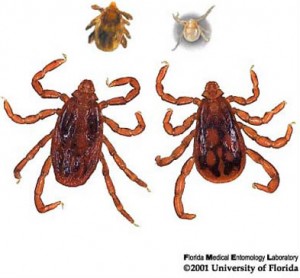READY TO GET STARTED?
REQUEST A FREE ESTIMATE
Fill out the form below or call (888) 466-7849 for a free, no-obligation estimate.

Summer brings hot temperatures and high humidity. It also brings some of the most annoying pests – fleas and ticks. These parasites can cause significant health issues for your pets including Lyme disease, anaplasmosis, and ehrlichiosis. Fleas and ticks are practically impossible to keep at bay and can take weeks to months to get under control. What can you do to protect your pets from these parasites? Check out these 8 tips to prevent fleas and ticks from taking over your pets and your home.
If you suspect a flea or tick problem, call a professional pest control company who can come and thoroughly inspect your home and yard and provide you with a comprehensive treatment and prevention plan.
Each warm season brings questions from homeowners and pet owners regarding ticks. We worry about our furry family members and ourselves if we plan on spending time outdoors, especially in or around wooded areas.
The brown dog tick is one species of tick that should be cause for concern, especially for those who have dogs. Although they feed on a wide variety of mammals, dogs are their preferred host. These ticks are unique in that they can complete an entire life cycle indoors. They feed on the host for about a week before dropping off and laying their eggs…up to 5,000 eggs!! After she’s done laying her eggs, she dies. The full life cycle of a brown dog tick lasts just over two months and generally are long living creatures.

Tick Life Cycle – Source
A brown dog tick infestation can develop in high quantities and very quickly. Oftentimes, ticks go unnoticed on dogs until the ticks are spotted throughout the home.
To protect your home and your dog from brown tick infestation, here are some brown dog tick control tips:
For more detailed information on the brown dog tick, visit http://www.entnemdept.ufl.edu/creatures/urban/medical/brown_dog_tick.htm.
 Nobody likes mosquitoes! Especially, your four-legged friends. Besides being just plain annoying, mosquitoes carry many diseases that affect both humans and animals. Heartworms are among the diseases that are carried by mosquitoes and can be a horrible disease for your furry friend to contract. The key to mosquito protection is prevention.
Nobody likes mosquitoes! Especially, your four-legged friends. Besides being just plain annoying, mosquitoes carry many diseases that affect both humans and animals. Heartworms are among the diseases that are carried by mosquitoes and can be a horrible disease for your furry friend to contract. The key to mosquito protection is prevention.
A heartworm is a parasitic worm that lives in the heart and lungs of an infected animal. The worms travel through the bloodstream, damaging arteries and vital organs as they go, finally finishing their trip to the lungs and heart about six months after the initial infection. Several hundred worms can live in one dog for up to five to seven years. Heartworm disease can be fatal and should be taken seriously.
Mosquitoes carry heartworms and transmit them from animal to animal. The life cycle of the heartworm is intricate. An animal must have at least two heartworms (a male and a female) in order for female heartworms to reproduce.
Struggled breathing, coughing, vomiting, weight loss, weariness, and fatigue after only moderate exercise are signs of heartworm infestation. However, some dogs exhibit no symptoms at all until late stages of infection. Heartworm treatment can be very expensive for you and very painful for your precious pet. This is why it is so important to have your pet examined by a veterinarian on a regular basis and to keep them on a preventative plan. Heartworms do not discriminate – any dog can get infected. And while it is less of a threat to cats, they can still get heartworms as well. So keep your feline friend protected too!
Turn your mosquito magnets into mosquito repellants with Northwest Exterminating Mosquito Control!
Has your pet ever been heartworm positive?
How can something as small as a flea be such a huge pain? Pet owners are all too familiar with the annoyance of fleas because they make us AND our pets miserable. Fleas attach themselves to warm-blooded animals (pets and humans) and feed on their blood. A flea bite can cause discomfort, painful, itchy red bumps and can lead to an allergic reaction. In some cases, they can even transmit diseases like the bubonic plague, murine typhus and transfer tapeworms in pets.
To prevent fleas from becoming a pest in your home, clean and vacuum frequently. A clean home is a healthy home and will aid in the prevention of other pests as well. Cleaning will help to remove any fleas and their eggs. Maintaining a clean yard is just as important, especially if you have pets that go outside often. A well kept lawn with no debris or pet droppings will reduce the flea population around your home. Bathe pets regularly and apply a flea and tick treatment. Most importantly, call a professional exterminator if you have fleas in your home. A flea infestation can be very difficult to get rid of and is best left to the professionals so the problem does not continue to grow.
Interesting Flea Facts:
Got a flea problem? Call Northwest Exterminating for professional, effective flea control.
How can something as small as a flea be such a huge pain? Pet owners are all too familiar with the annoyance of fleas because they make us AND our pets miserable. Fleas attach themselves to warm-blooded animals (pets and humans) and feed on their blood. A flea bite can cause discomfort, painful, itchy red bumps and can lead to an allergic reaction. In some cases, they can even transmit diseases like the bubonic plague, murine typhus and transfer tapeworms in pets.
To prevent fleas from becoming a pest in your home, clean and vacuum frequently. A clean home is a healthy home and will aid in the prevention of other pests as well. Cleaning will help to remove any fleas and their eggs. Maintaining a clean yard is just as important, especially if you have pets that go outside often. A well kept lawn with no debris or pet droppings will reduce the flea population around your home. Bathe pets regularly and apply a flea and tick treatment. Most importantly, call a professional exterminator if you have fleas in your home. A flea infestation can be very difficult to get rid of and is best left to the professionals so the problem does not continue to grow.
Interesting Flea Facts:
Got a flea problem? Call Northwest Exterminating for professional, effective flea control.